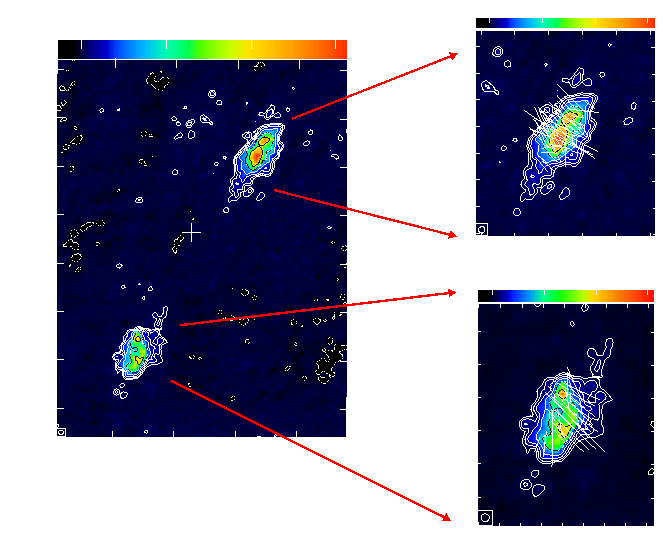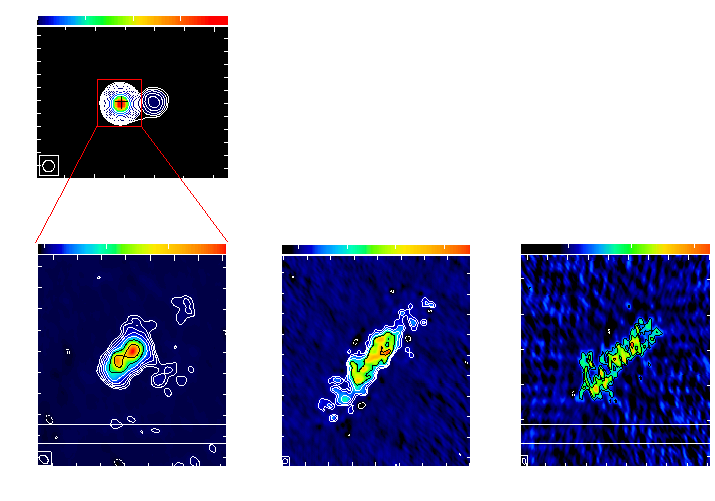|
The Gigahertz-Peaked Spectrum (GPS) and Compact Steep Spectrum (CSS)
sources make a significant fraction of radio-loud AGNs. Their projected
linear sizes are less than 20 kpc (H0=100 km s-1 Mpc-1 and q0=0.5) and
can be explained by the evolution theory. According to it (Philips & Mutel, 1982;
Readhead et al., 1996), the
CSS sources are precursors of older Large Symmetric Objects (LSO) and
GPS sources may be earlier stages of CSS objects. However, it has been
suggested that the activity of extragalactic radio sources is intermittent
on the timescales of ~104-105 years (Reynolds & Begelman, 1997), which means that some small scale
objects will never reach the LSO stage. As a result we should observe a large
number of fading compact CSS/GPS objects or those showing a restarted
activity (Marecki et al. 2003; Kunert-Bajraszewska et al., 2006, A&A, 450, 945).
We have selected a sample of 60 candidates
from the VLA FIRST catalogue which could be weak Compact Steep Spectrum sources.
All these sources were
initially observed with MERLIN at 5 GHz and the results of these observations
led to the selection of several groups of objects for further study with
MERLIN, VLA and VLBA. The observations were made in a snapshot mode with
phase referencing in 2002-2004 (Kunert-Bajraszewska et al., 2005,2006,
2007).
Evidence has been mounting recently that activity in some radio-loud
AGNs (RLAGNs) can cease shortly after ignition and that perhaps even a majority
of very compact sources may be short-lived phenomena because of a lack of stable
fuelling from the black hole. Thus, they can fade out before having evolved to
large, extended objects. Re-ignition of the activity in such objects is not
ruled out.
The aim of our observations was finding more examples of these objects and to investigate
if they could be RLAGNs switched off at very early
stages of their evolution.
1542+323.
This source is our first cadidate for a fader. A full-track MERLIN observations at
5 GHz of 1542+323 shows two radio lobes without visible hotspots and without a core.
Also, there is no change in the direction of the polarisation vectors in the regions
of maximum intensity which one might expect if there were active hotspots.
More information about this source can be found in an article
Kunert-Bajraszewska i in, 2005, A&A, 440, 93.

Fig. 1. The 5 GHz MERLIN map (12-h observations) of the overall structure
of 1542+323 and the individual lobes including polarisation vectors. Cross indicates
the position of an optical object found using SDSS. Contours increase
by a factor 2 and the first contour level corresponds to ~3s.
-
0809+404.
This source is dominated by a compact component but also has diffuse,
arcsecond-scale emission visible in VLA images (Fanti et al., 2001, A&A, 369, 380).
Our VLBI observations of the "core" structure have revealed that this is also
diffuse and fading away at higher frequencies. The above result is an indication
that the activity of the host galaxy of 0809+404 may be intermittent. Previous
observations obtained from the literature and those presented here indicate that
activity had ceased once in the past, then restarted, and has recently switched
off again.
More information about this source can be found in an article
Kunert-Bajraszewska i in, 2006, A&A, 450, 945.
Click for enlarge

Fig. 2. The 4.9 GHz VLA map of 0809+404 (Fanti i in, 2001, A&A, 369, 380) and
our VLBA observations at 1.7, 5 and 8.4 GHz. Contours increase
by a factor 2 and the first contour level corresponds to ~3s. Cross
indicates the position of an optical object found using SDSS.There is no trace
of this source in 15 GHz VLBA observations. 0809+404 is a type II quasar and
its largest linear size at VLA resolution is equal to 4.5 kpc (z=0.551).
|
|
 cv publications
projects
cv publications
projects

